Effectiveness and Efficiency of Corral Traps, Drop Nets and Suspended Traps for Capturing Wild Pigs (Sus scrofa)
Abstract
Simple Summary
Abstract
1. Introduction
2. Materials and Methods
2.1. Study Area—Experiment 1
2.2. Study Area—Experiment 2
2.3. Camera Surveys
2.4. Trapping
2.5. Effectiveness
2.6. Efficiency
3. Results
3.1. Trapping
3.2. Effectiveness
3.3. Efficiency
4. Discussion
5. Conclusions
6. Patents
Author Contributions
Funding
Institutional Review Board Statement
Data Availability Statement
Acknowledgments
Conflicts of Interest
References
- Bevins, S.N.; Pedersen, K.; Lutman, M.W.; Gidlewski, T.; Deliberto, T.J. Consequences associated with the recent range expansion of nonnative feral swine. Bioscience 2014, 64, 291–299. [Google Scholar] [CrossRef]
- Brook, R.K.; van Beest, F.M. Feral wild boar distribution and perceptions of risk on the central Canadian prairies. Wildl. Soc. Bull. 2014, 38, 486–494. [Google Scholar] [CrossRef]
- Snow, N.P.; Jarzyna, M.A.; VerCauteren, K.C. Interpreting and predicting the spread of invasive wild pigs. J. Appl. Ecol. 2017, 54, 2022–2032. [Google Scholar] [CrossRef]
- Salvador, C.H.; Fernandez, F. Biological invasion of wild boar and feral pigs Sus scrofa (Suidae) in South America: Review and mapping with implications for conservation of peccaries (Tayassuidae). In Ecology, Conservation and Management of Wild Pigs and Peccaries; Mellettie, M., Meijaard, E., Eds.; Cambridge University Press: Cambridge, UK, 2018; pp. 313–324. [Google Scholar]
- Keuling, O.; Baubet, E.; Duscher, A.; Ebert, C.; Fischer, C.; Monaco, A.; Prevot, C.; Ronnenberg, K.; Sodeikat, G.; Stier, N.; et al. Mortality rates of wild boar Sus scrofa L. in central Europe. Eur. J. Wildl. Res. 2013, 59, 805–814. [Google Scholar] [CrossRef]
- Hone, J. Feral pigs in Namadgi National Park, Australia: Dynamics, impacts and management. Biol. Conserv. 2002, 105, 231–242. [Google Scholar] [CrossRef]
- Tabak, M.A.; Piaggio, A.J.; Miller, R.S.; Sweitzer, R.A.; Ernest, H.B. Anthropogenic factors predict movement of an invasive species. Ecosphere 2017, 8, e01844. [Google Scholar] [CrossRef]
- Hernández, F.A.; Parker, B.M.; Pylant, C.L.; Smyser, T.J.; Piaggio, A.J.; Lance, S.L.; Milleson, M.P.; Austin, J.D.; Wisely, S.M. Invasion ecology of wild pigs (Sus scrofa) in Florida, USA: The role of humans in the expansion and colonization of an invasive wild ungulate. Biol. Invasions 2018, 20, 1865–1880. [Google Scholar] [CrossRef]
- Valéry, L.; Fritz, H.; Lefeuvre, J.-C.; Simberloff, D. In search of a real definition of the biological invasion phenomenon itself. Biol. Invasions 2008, 10, 1345–1351. [Google Scholar] [CrossRef]
- West, B.C.; Cooper, A.L.; Armstrong, J.B. Managing wild pigs: A technical guide. Hum. Wildl. Interact. Monogr. 2009, 1, 1–55. [Google Scholar]
- Peine, J.D.; Farmer, J.A. Wild hog management program at Great Smoky Mountains National Park. Proc. Vertebr. Pest Conf. 1990, 14, 221–227. [Google Scholar]
- Choquenot, D.; McIlroy, J.; Korn, T. Managing Vertebrate Pests: Feral Pigs; Bureau of Resource Services, Australian Government Publishing Service: Canberra, Australia, 1996. [Google Scholar]
- Taft, A.C. Feral swine-national concerns. In Proceedings of the 1999 National Feral Swine Symposium; Texas Animal Health Commission: Austin, TX, USA, 1999; pp. 25–26. [Google Scholar]
- Engeman, R.M.; Smith, H.T.; Severson, R.; Severson, M.A.; Woolard, J.; Shwiff, S.A.; Constantin, B.; Griffin, D. Damage reduction estimates and benefit-cost ratios for feral swine control from the last remnant of a basin marsh system in Florida. Environ. Conserv. 2004, 31, 207–211. [Google Scholar] [CrossRef]
- Engeman, R.M.; Constantin, B.U.; Shwiff, S.A.; Smith, H.T.; Woolard, J.; Allen, J.; Dunlap, J. Adaptive and economic management methods for feral hog control in Florida. Hum. Wildl. Conflicts 2007, 1, 178–185. [Google Scholar]
- McCann, B.E.; Garcelon, D.K. Eradication of feral pigs from Pinnacles National Monument. J. Wildl. Manag. 2008, 72, 1287–1295. [Google Scholar] [CrossRef]
- Frauendorf, M.; Gethöffer, F.; Siebert, U.; Keuling, O. The influence of environmental and physiological factors on the litter size of wild boar (Sus scrofa) in an agriculture dominated area in Germany. Sci. Total Environ. 2016, 541, 877–882. [Google Scholar] [CrossRef]
- Torres-Blas, I.; Mentaberre, G.; Castillo-Contreras, R.; Fernández-Aguilar, X.; Conejero, C.; Valldeperes, M.; González-Crespo, C.; Colom-Cadena, A.; Lavín, S.; López-Olvera, J.R. Assessing methods to live-capture wild boars (Sus scrofa) in urban and peri-urban environments. Vet. Rec. 2020, 187, e85. [Google Scholar] [CrossRef]
- Lowe, S.; Browne, M.; Boudjelas, S.; De Poorter, M. 100 of the World’s Worst Invasive Alien Species: A Selection from the Global Invasive Species Database; The Invasive Species Specialist Group, Species Survival Commission, World Conservation Union: Auckland, NZ, Australia, 2000. [Google Scholar]
- Mellish, J.M.; Sumrall, A.; Campbell, T.A.; Collier, B.A.; Neill, W.H.; Higginbotham, B.; Lopez, R.R. Simulating potential population growth of wild pig, Sus scrofa, in Texas. Southeast. Nat. 2014, 13, 367–376. [Google Scholar] [CrossRef]
- Taylor, R. The Feral Hog in Texas; Texas Parks and Wildlife Department: Austin, TX, USA, 1991. [Google Scholar]
- Stevens, R.L. The Feral Hog in Oklahoma, 2nd ed.; The Samuel Roberts Noble Foundation, Inc.: Ardmore, OK, USA, 2010. [Google Scholar]
- Gaskamp, J.A.; Cathey, J.C.; Higginbotham, B.; Bodenchuk, M.J. Wild pigs in south-central North America. In Invasive Wild Pigs in North America: Ecology, Impacts, and Management; VerCauteren, K.C., Beasley, J.C., Ditchkoff, S.S., Mayer, J.J., Roloff, G.J., Strickland, B.K., Eds.; CRC Press: Boca Raton, FL, USA, 2020; pp. 347–368. [Google Scholar]
- VerCauteren, K.C.; Mayer, J.J.; Beasley, J.C.; Ditchkoff, S.S.; Roloff, G.J.; Strickland, B.K. Introduction. In Invasive Wild Pigs in North America: Ecology, Impacts, and Management; VerCauteren, K.C., Beasley, J.C., Ditchkoff, S.S., Mayer, J.J., Roloff, G.J., Strickland, B.K., Eds.; CRC Press: Boca Raton, FL, USA, 2020; pp. 1–5. [Google Scholar]
- Gaskamp, J.A.; Gee, K.L.; Campbell, T.A.; Silvy, N.J.; Webb, S.L. Damage caused to rangelands by wild pig rooting activity is mitigated with intensive trapping. Cogent Environ. Sci. 2018, 4, 1540080. [Google Scholar] [CrossRef]
- Boyer, K.S.; Fairbanks, W.S.; Rohla, C.; Webb, S.L. Surficial soil damage by wild pigs (Sus scrofa) decreases pecan harvest efficiency. Crop Prot. 2020, 128, 104992. [Google Scholar] [CrossRef]
- Gaskamp, J.A.; Gee, K.L.; Campbell, T.A.; Silvy, N.J.; Webb, S.L. Pseudorabies virus and Brucella abortus from an expanding wild pig (Sus scrofa) population in southern Oklahoma. J. Wildl. Dis. 2016, 52, 383–386. [Google Scholar] [CrossRef]
- Haydett, K.M. Seroprevalence of Neospora caninum in a wild pig (Sus scrofa) population in Oklahoma. Master’s Thesis, Texas Tech University, Lubbock, TX, USA, 2018. [Google Scholar]
- Peper, S.T.; Hoffarth, A.; Athanasiou, K.; Hawkins, S.L.; Wilson-Fallon, A.N.; Gibson, A.; Webb, C.R.; Gaskamp, J.A.; Webb, S.L.; Haydett, K.M.; et al. Brucella spp. and Francisella tularensis from an invasive alien species (Sus scrofa) in the southcentral United States. Ecosphere 2021, 12, e03426. [Google Scholar] [CrossRef]
- Bodenchuk, M.J. Method-specific costs of feral swine removal in a large metapopulation: The Texas experience. In Proceedings of the 26th Vertebrate Pest Conference; Timm, R.M., O’Brien, J.M., Eds.; University of California-Davis: Davis, CA, USA, 2014; pp. 269–271. [Google Scholar]
- Diong, C.H. Responses of wild pigs to trap types and food baits. In Proceedings of the Third Conference in Natural Sciences; Smith, C.W., Ed.; Hawaii Volcanoes National Park; University of Hawaii: Honolulu, HI, USA, 1980; pp. 91–99. [Google Scholar]
- Choquenot, D.; Kilgour, R.J.; Lukins, B.S. An evaluation of feral pig trapping. Wildl. Res. 1993, 20, 653–665. [Google Scholar] [CrossRef]
- Sweeney, J.R.; Sweeney, J.M.; Sweeney, S.W. Feral hog Sus scrofa. In Wild Mammals of North America Biology, Management, and Conservation, 2nd ed.; Feldhamer, G.A., Thompson, B.C., Chapman, J.A., Eds.; John Hopkins University Press: Baltimore, MA, USA, 2003; pp. 1164–1179. [Google Scholar]
- Hamrick, B.; Smith, M.; Jaworowski, C.; Strickland, B. A Landowner’s Guide for Wild Pig Management: Practical Methods for Wild Pig Control; Mississippi State University Extension Program: Starkville, MI, USA, 2011. [Google Scholar]
- Gee, K.L.; Holman, J.H.; Demarais, S. A man-power efficient drop-net system for capturing white-tailed deer. Proc. Annu. Southeast Deer Study Group 1999, 22, 31. [Google Scholar]
- Schemnitz, S.D.; Batcheller, G.R.; Lovallo, M.J.; White, H.B.; Fall, M.W. Capturing and handling wild animals. In The Wildlife Techniques Manual: Research, 7th ed.; Silvy, N.J., Ed.; The Johns Hopkins University Press: Baltimore, MA, USA, 2012; pp. 64–117. [Google Scholar]
- Gee, K.L. (Oaks and Prairies Joint Venture [Current Affiliation], Gene Autry, OK, USA. Noble Research Institute, LLC (formerly The Samuel Roberts Noble Foundation, Inc.) [affiliation during personal observation]: Ardmore, OK, USA). Personal observation, 1998.
- Gee, K.L.; Porter, M.D.; Demarais, S.; Bryant, F.C. White-Tailed Deer: Their Foods and Management in the Cross Timbers; The Samuel Roberts Noble Foundation, Inc.: Ardmore, OK, USA, 2011. [Google Scholar]
- Gaskamp, J.A. Use of Drop-Nets for Wild Pig Damage and Disease Abatement. Master’s Thesis, Texas A&M University, College Station, TX, USA, 2012. [Google Scholar]
- Jacobson, H.A.; Kroll, J.C.; Browning, R.W.; Koerth, B.H.; Conway, M.H. Infrared-triggered cameras for censusing white-tailed deer. Wildl. Soc. Bull. 1997, 25, 547–556. [Google Scholar]
- McKinley, W.T.; Demarais, S.; Gee, K.L.; Jacobson, H.A. Accuracy of the camera technique for estimating white-tailed deer population characteristics. Proc. Southeast. Assoc. Fish Wildl. Agen. 2006, 60, 83–88. [Google Scholar]
- Andrewartha, H.G. Introduction to the Study of Animal Populations, 2nd ed.; University of Chicago Press: Chicago, IL, USA, 1971. [Google Scholar]
- Lancia, R.A.; Nichols, J.D.; Pollock, K.H. Estimating the number of animals in wildlife populations. In Research and Management Techniques for Wildlife and Habitats, 5th ed.; Bookhout, T.A., Ed.; The Wildlife Society: Bethesda, MA, USA, 1996; pp. 215–253. [Google Scholar]
- Lincoln, F.C. Calculating waterfowl abundance on the basis of banding returns. US Dep. Agric. Circ. 1930, 118, 1–4. [Google Scholar]
- Miththapala, S.; Seidensticker, J.; Phillips, L.G.; Fernando, S.B.U.; Smallwood, J.A. Identification of individual leopards (Panthera pardus kotiya) using spot pattern variation. J. Zool. 1989, 218, 527–536. [Google Scholar] [CrossRef]
- Heilbrun, R.D.; Silvy, N.J.; Peterson, M.J.; Tewes, M.E. Estimating bobcat abundance using automatically triggered cameras. Wildl. Soc. Bull. 2006, 34, 69–73. [Google Scholar] [CrossRef]
- Harrison, R.L. Noninvasive identification of individual American badgers by features of their dorsal head stripes. West. N. Am. Nat. 2016, 76, 259–261. [Google Scholar] [CrossRef]
- Alexander, P.D.; Gese, E.M. dentifying individual cougars (Puma concolor) in remote camera images—Implications for population estimates. Wildl. Res. 2018, 45, 274–281. [Google Scholar] [CrossRef]
- Timmons, J.B.; Higginbotham, B.; Lopez, R.; Cathey, J.C.; Mellish, J.; Griffin, J.; Sumrall, A.; Skow, K. Feral Hog Population Growth, Density and Harvest in Texas; Texas A&M University: College Station, TX, USA, 2012. [Google Scholar]
- Bodenchuk, M.J. Feral hog management: Tying performance measures to resources protected. In National Conference on Feral Hogs; Vantassel, S.M., Ed.; Missouri Department of Conservation: St. Louis, MI, USA, 2008; pp. 1–4. [Google Scholar]
- Davis, A.J.; Leland, B.; Bodenchuk, M.; VerCauteren, K.C.; Pepin, K.M. Costs and effectiveness of damage management of an overabundant species (Sus scrofa) using aerial gunning. Wildl. Res. 2018, 45, 696–705. [Google Scholar] [CrossRef]
- Campbell, T.A.; Long, D.B. Mammalian visitation to candidate feral swine attractants. J. Wildl. Manag. 2008, 72, 305–309. [Google Scholar] [CrossRef]
- Sumrall, S.A. Abatement Strategies and Disease Assessment for Feral Hogs in East Texas. Ph.D. Thesis, Texas A&M University, College Station, TX, USA, 2011. [Google Scholar]
- Williams, B.L.; Holtfreter, R.W.; Ditchkoff, S.S.; Grand, J.B. Trap style influences wild pig behavior and trapping success. J. Wildl. Manag. 2011, 75, 432–436. [Google Scholar] [CrossRef]
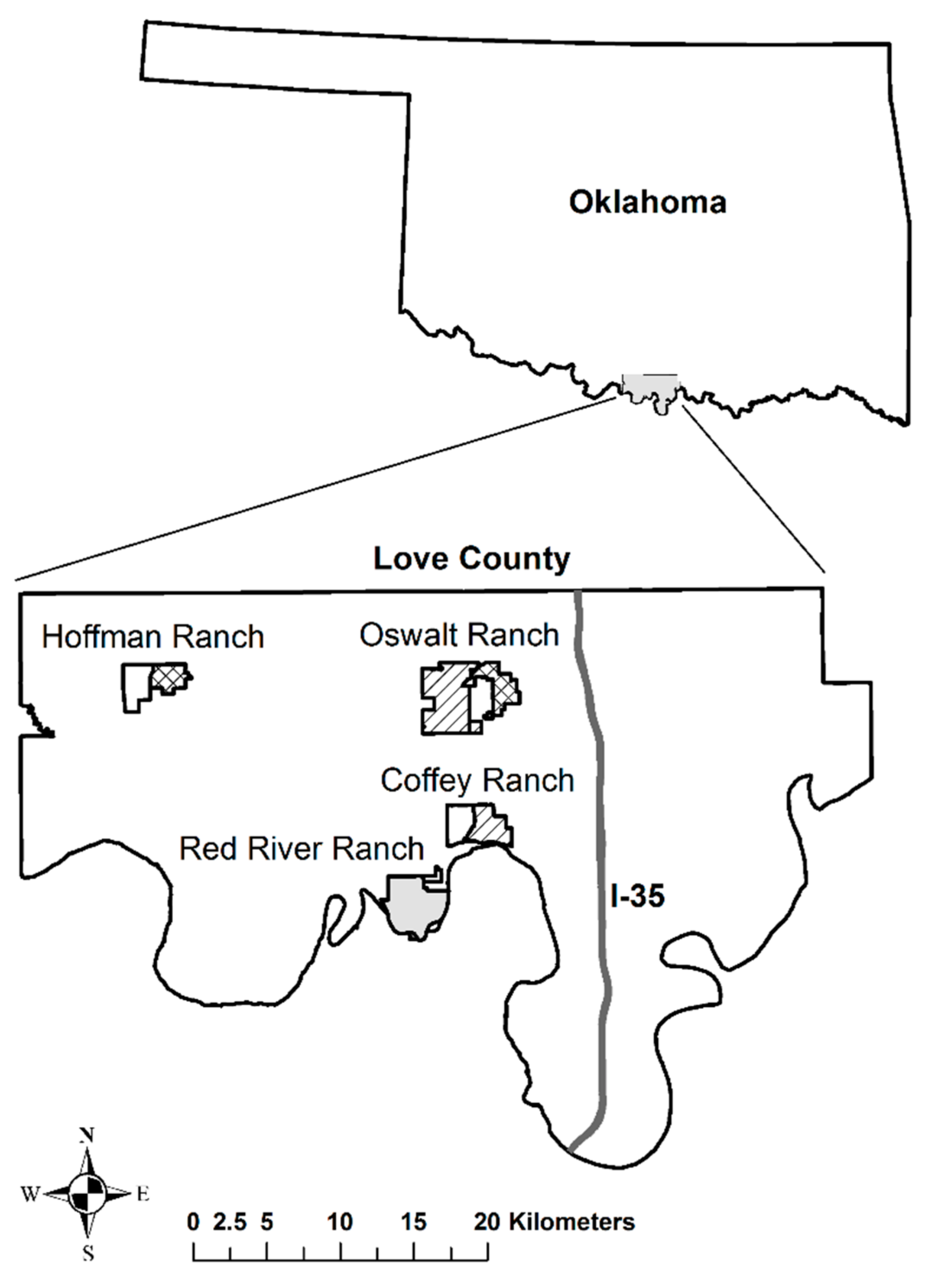
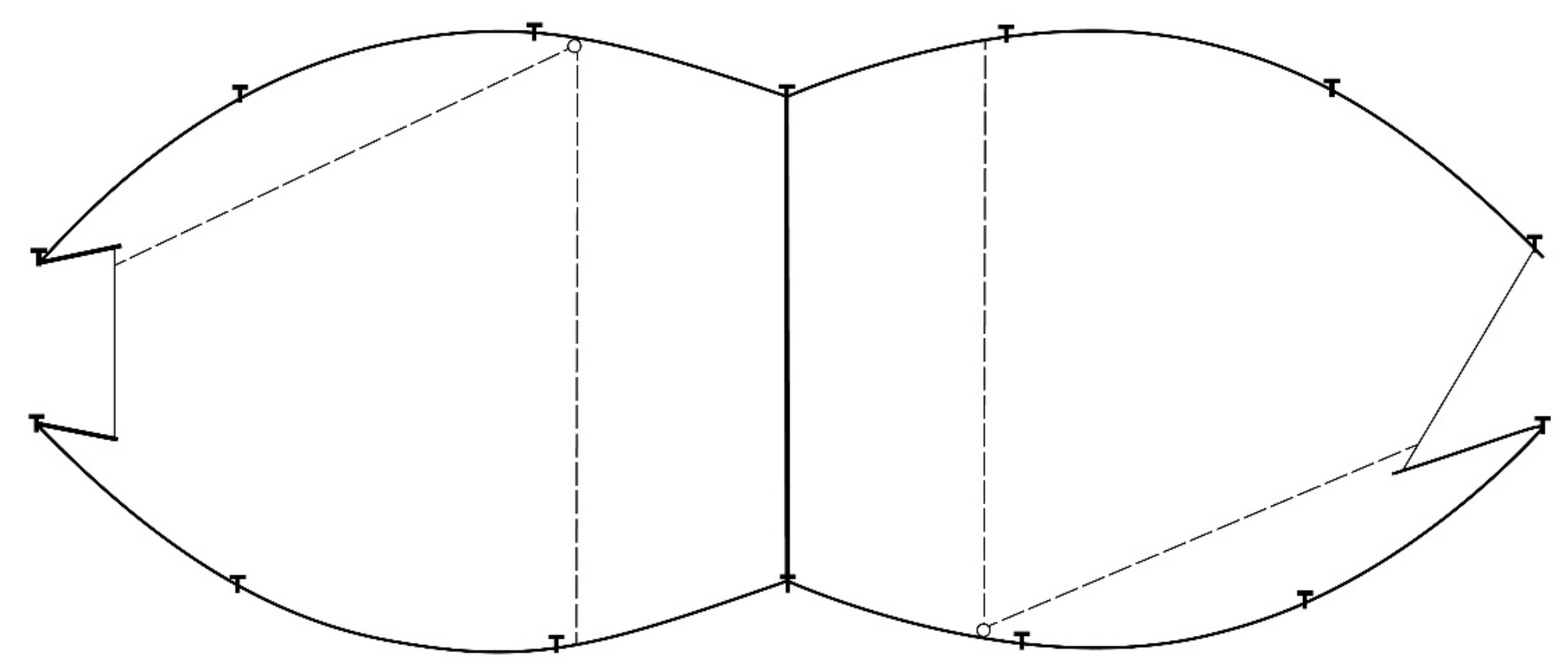
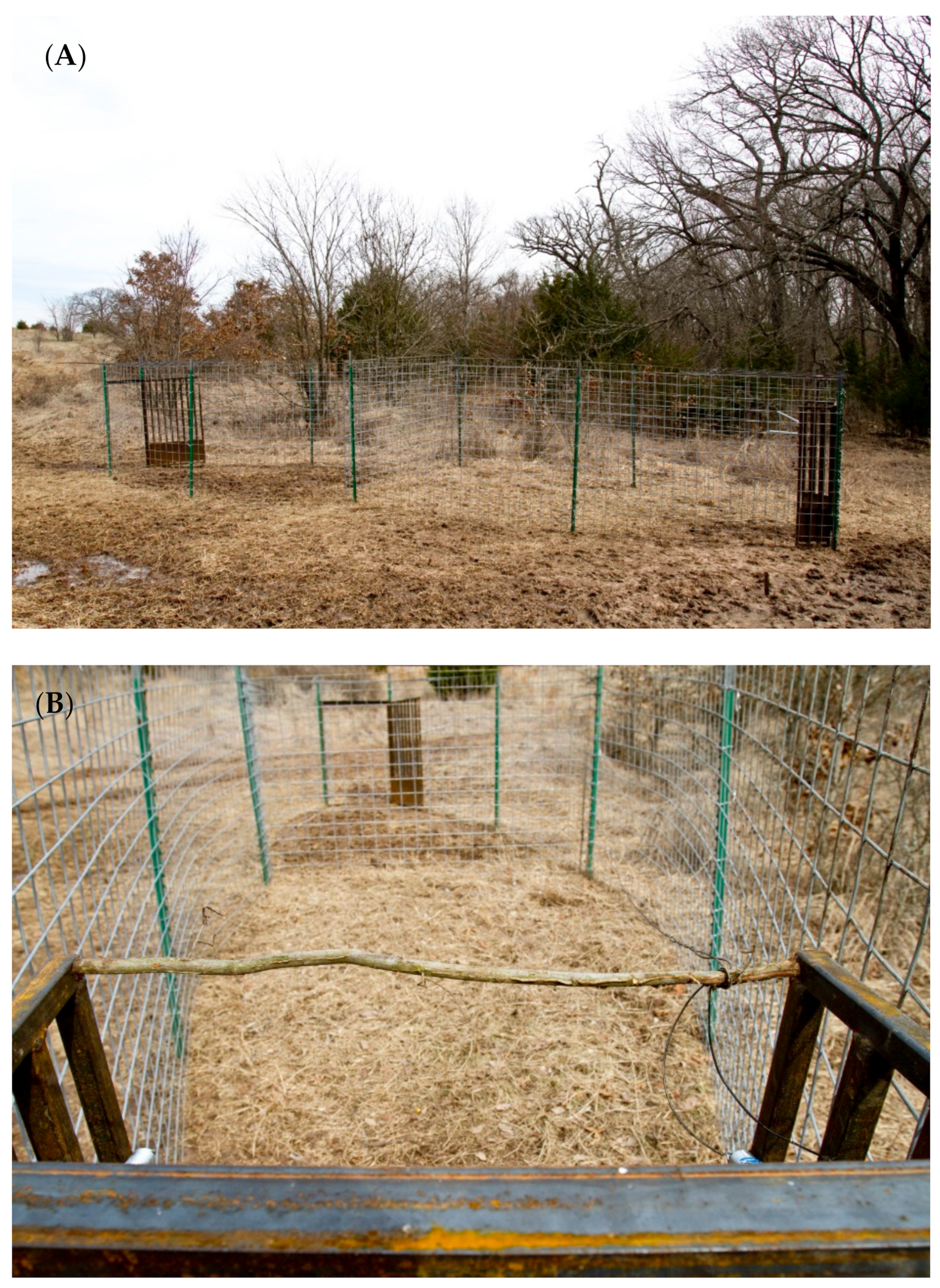

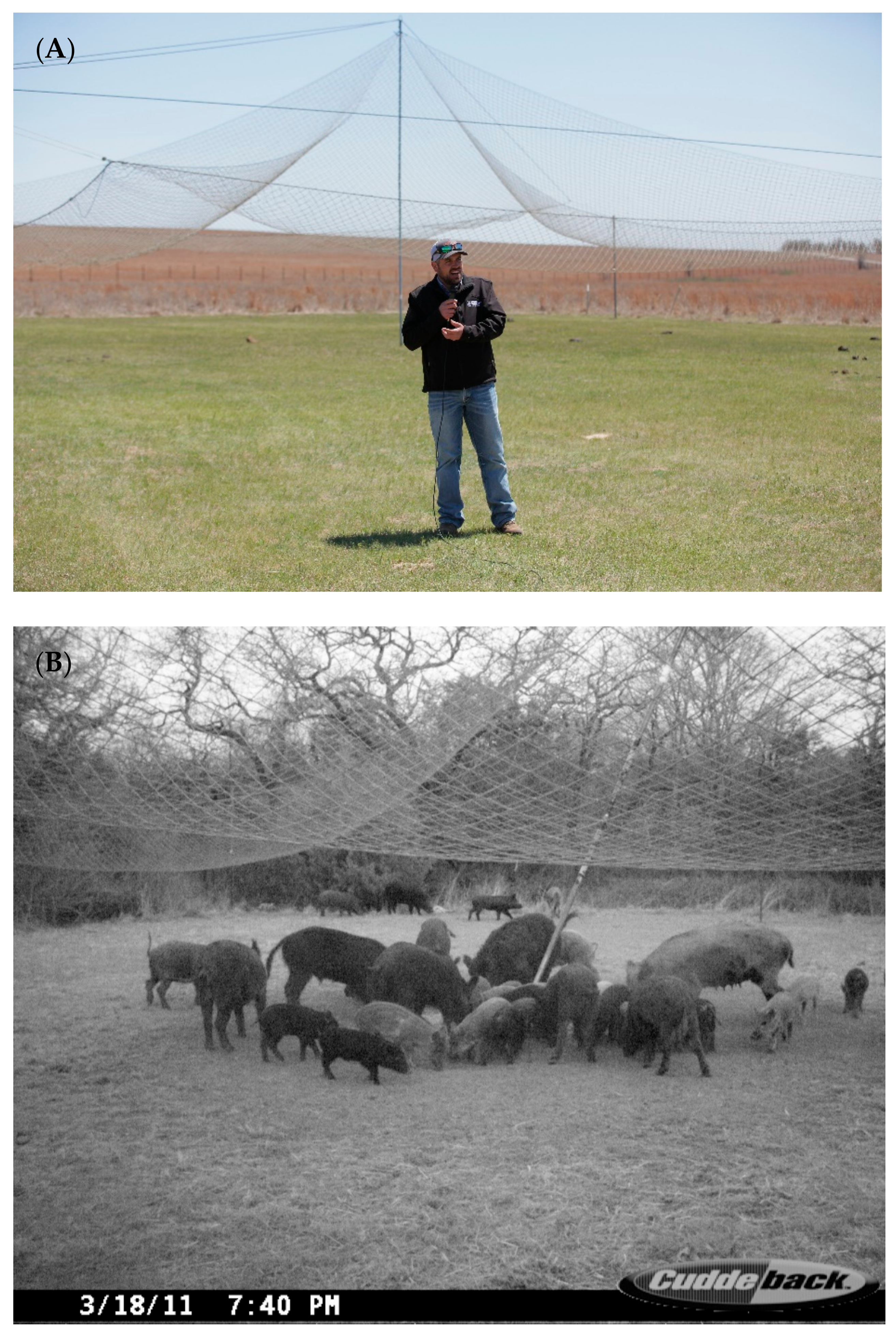
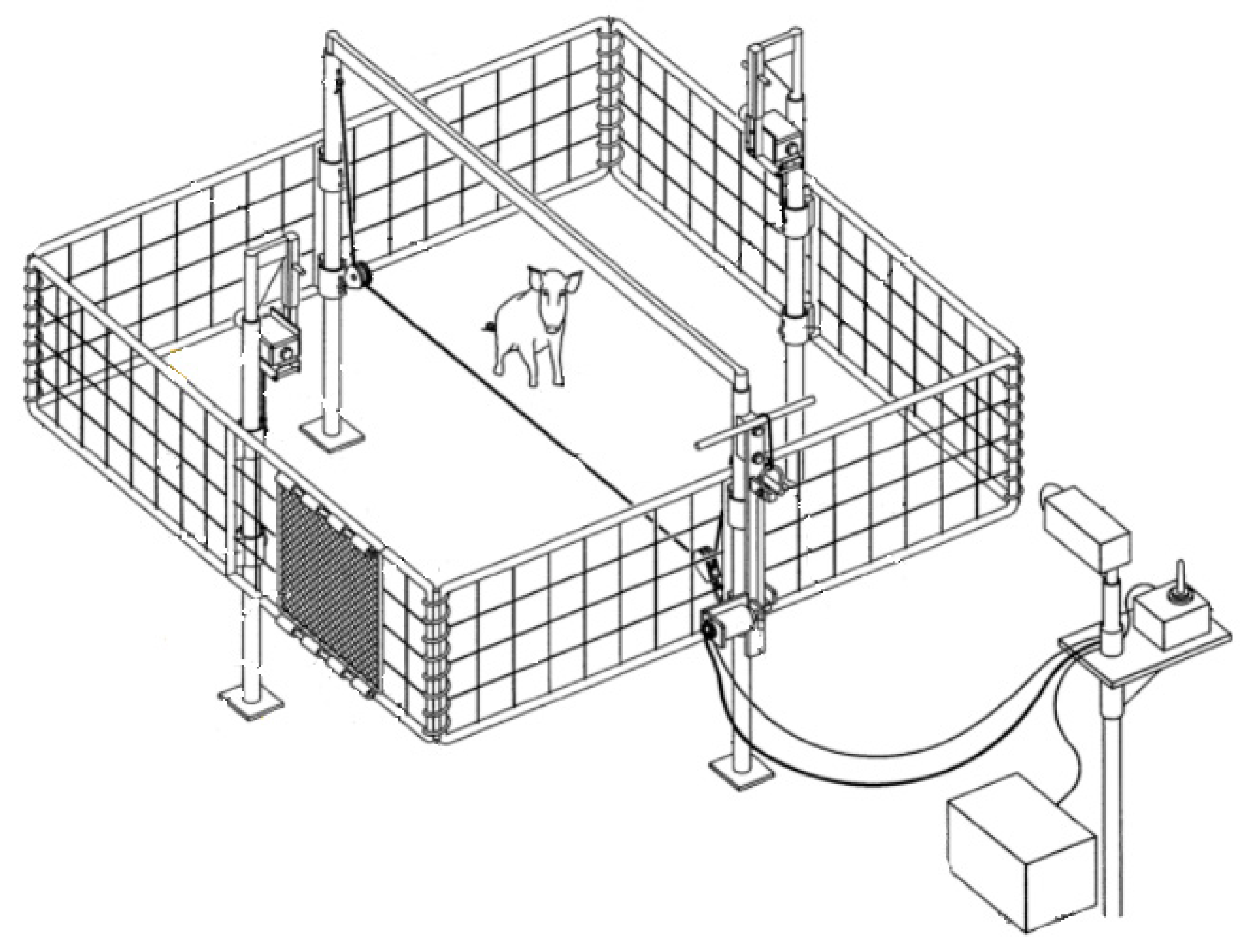
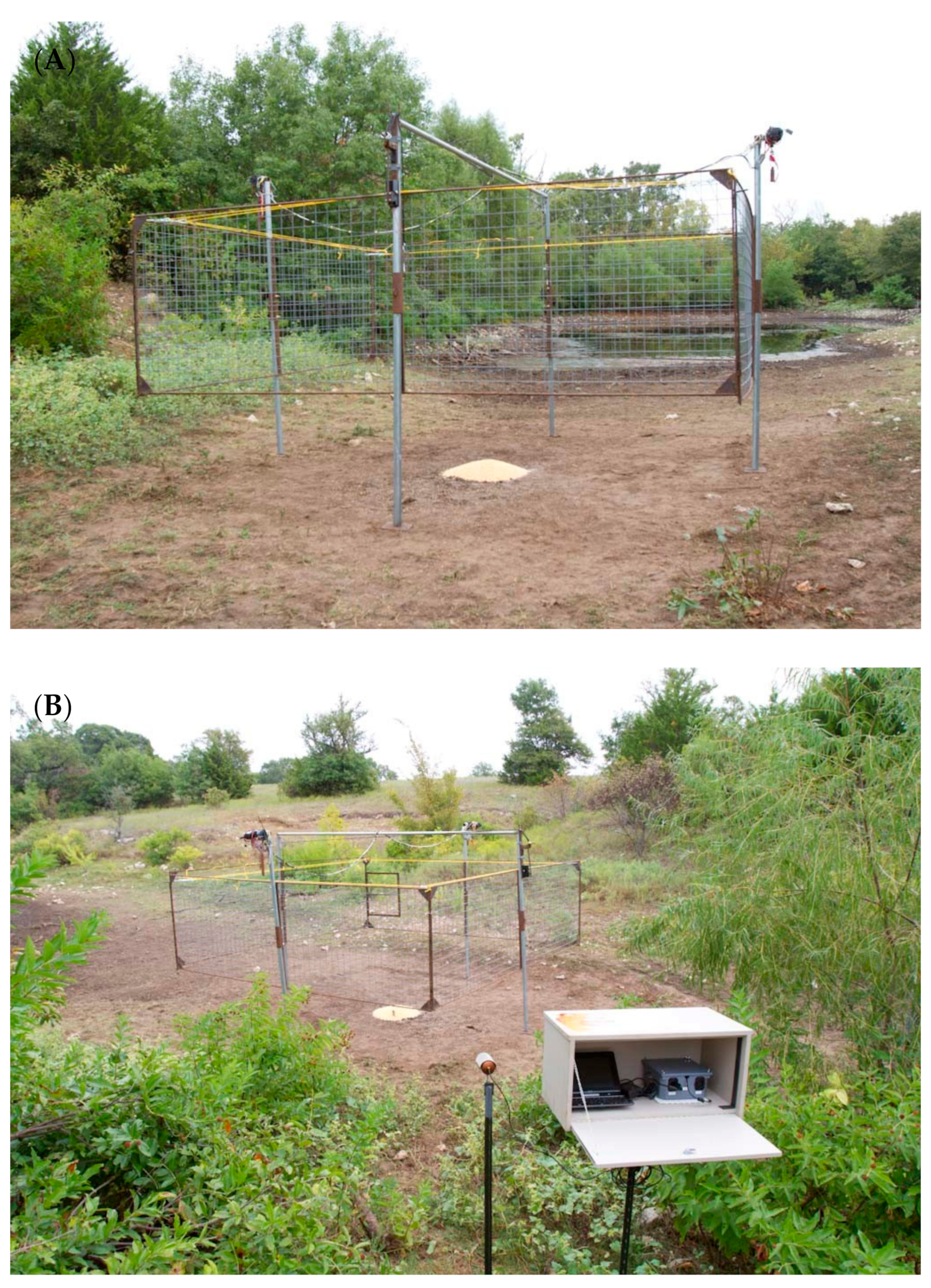
| Year | Trap | Ranch | Marked (M; n) | Captured (N; n) | Recaptured (R; n) | Population (P; n) | Effectiveness (N/P) |
|---|---|---|---|---|---|---|---|
| 2010 | Drop net | Coffey | 55 | 55 | 51 | 59.3 | 0.927 |
| Oswalt Road | 63 | 55 | 55 | 63 | 0.873 | ||
| Corral | Hoffmann | 11 | 8 | 8 | 11 | 0.727 | |
| Oswalt Road | 17 | 15 | 8 | 31 | 0.484 | ||
| 2011 | Drop net | Coffey | 51 | 50 | 47 | 54.25 | 0.922 |
| Oswalt Road | 54 | 39 | 38 | 55.4 | 0.704 | ||
| Corral | Hoffmann | 11 | 4 | 4 | 11 | 0.364 | |
| Oswalt Road | 0 | 0 | 0 | 0 | -- | ||
| Coffey | 34 | 26 | 26 | 34 | 0.807 | ||
| 2012 | Suspended trap | Oswalt Road | 42 | 40 | 40 | 42 | 0.951 |
| Red River | 21 | 40 | 18 | 46.5 | 0.85 |
| Activity | Drop Net (%) | Corral Trap (%) | Suspended Trap (%) |
|---|---|---|---|
| Construction/maintenance 1 | 17 | 36 | 26 |
| Baiting 2 | 30 | 58 | 66 |
| Trap observation 3 | 49 | 0 | 5 |
| Removal 4 | 4 | 6 | 8 |
Publisher’s Note: MDPI stays neutral with regard to jurisdictional claims in published maps and institutional affiliations. |
© 2021 by the authors. Licensee MDPI, Basel, Switzerland. This article is an open access article distributed under the terms and conditions of the Creative Commons Attribution (CC BY) license (https://creativecommons.org/licenses/by/4.0/).
Share and Cite
Gaskamp, J.A.; Gee, K.L.; Campbell, T.A.; Silvy, N.J.; Webb, S.L. Effectiveness and Efficiency of Corral Traps, Drop Nets and Suspended Traps for Capturing Wild Pigs (Sus scrofa). Animals 2021, 11, 1565. https://doi.org/10.3390/ani11061565
Gaskamp JA, Gee KL, Campbell TA, Silvy NJ, Webb SL. Effectiveness and Efficiency of Corral Traps, Drop Nets and Suspended Traps for Capturing Wild Pigs (Sus scrofa). Animals. 2021; 11(6):1565. https://doi.org/10.3390/ani11061565
Chicago/Turabian StyleGaskamp, Joshua A., Kenneth L. Gee, Tyler A. Campbell, Nova J. Silvy, and Stephen L. Webb. 2021. "Effectiveness and Efficiency of Corral Traps, Drop Nets and Suspended Traps for Capturing Wild Pigs (Sus scrofa)" Animals 11, no. 6: 1565. https://doi.org/10.3390/ani11061565
APA StyleGaskamp, J. A., Gee, K. L., Campbell, T. A., Silvy, N. J., & Webb, S. L. (2021). Effectiveness and Efficiency of Corral Traps, Drop Nets and Suspended Traps for Capturing Wild Pigs (Sus scrofa). Animals, 11(6), 1565. https://doi.org/10.3390/ani11061565







